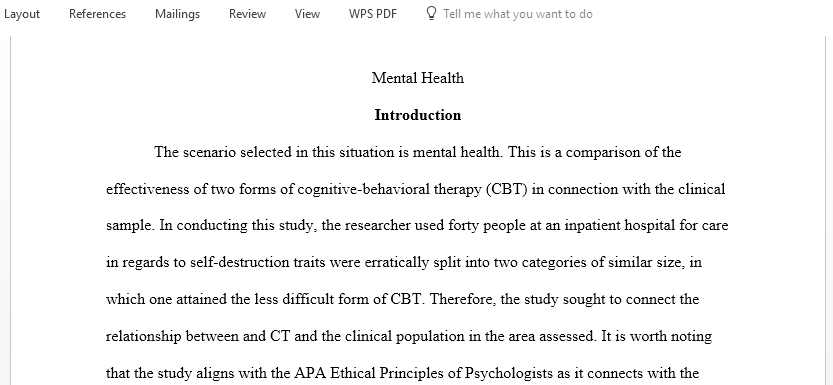Create a Mental Health statistical analysis report
Create a Mental Health statistical analysis report. Select a scenario from the Scenarios and Data Sets document to be the basis of your statistical analysis report. When deciding on which scenario to choose, determine which one is the most beneficial for your area of concentration in psychology. This statistical analysis report will inform stakeholders about the analysis and interpretation of the data presented in the scenario. Microsoft Excel is the recommended statistical software for this course, and the data sets are already placed into Excel files. You will first summarize your chosen scenario and discuss ethical issues. You will then begin your data analysis, determining the appropriate procedures in testing your hypothesis. Finally, you will summarize and interpret your results, making appropriate conclusions based on those results.
Specifically, the following critical elements must be addressed:
I. Introduction
A. Summarize the scenario you have chosen, including participants, the data set presented, and the question that can be answered by the data.
B. Discuss why the scenario exemplifies a study that agrees with APA’s Ethical Principles of Psychologists.
C. Discuss ethical issues that may potentially arise when analyzing and reporting statistical data.
D. Explain what you will do in your data analysis and reporting to ensure alignment with the expectations of APA’s Ethical Principles of
Psychologists.
II. Data Analysis
A. Identify the sample size and explain how it will inform your analysis. In other words, what is the sample size? How will the size of the sample
inform your analysis?
B. Select what statistical procedures should be implemented in your analysis, and justify why you feel these are appropriate.
C. Explain how statistical procedures can help you determine whether the data is attributable to chance factors.
D. Compute the mean and the standard deviation for each set of data using appropriate abbreviations and terminology.
E. Prepare an appropriately labeled histogram for each set of data.
F. Evaluate the shape of each distribution using your created histograms. In other words, what does the shape of each distribution tell us about the data?
III. Hypothesis
A. Determine whether one mean is higher, showing how you made the determination.
B. Identify the null hypothesis and alternative hypothesis using appropriate statistical symbols and language based on what you are comparing.
IV. Results
A. Based on your results, determine whether the data provide evidence for a valid effect.
B. Explain whether or not the results are statistically significant. Support your response with results from the data analysis.
C. Present properly labeled graphs representing the data analysis results detailed clearly for ease of stakeholder interpretation.
V. Conclusion
A. Explain your interpretation of the data. In other words, based on your results, what do you think the data mean? What are the potential
implications of this data for the stakeholders? What do these results mean for future research into the topic area?
B. Justify the data analysis procedures you used to reach your interpretation.
C. Discuss whether it would be appropriate to conduct more statistical procedures to further interpret the data.
(selected scenario Mental Health)
Answer preview for Create a Mental Health statistical analysis report

Access the full answer containing 1240 words by clicking the below purchase button.
